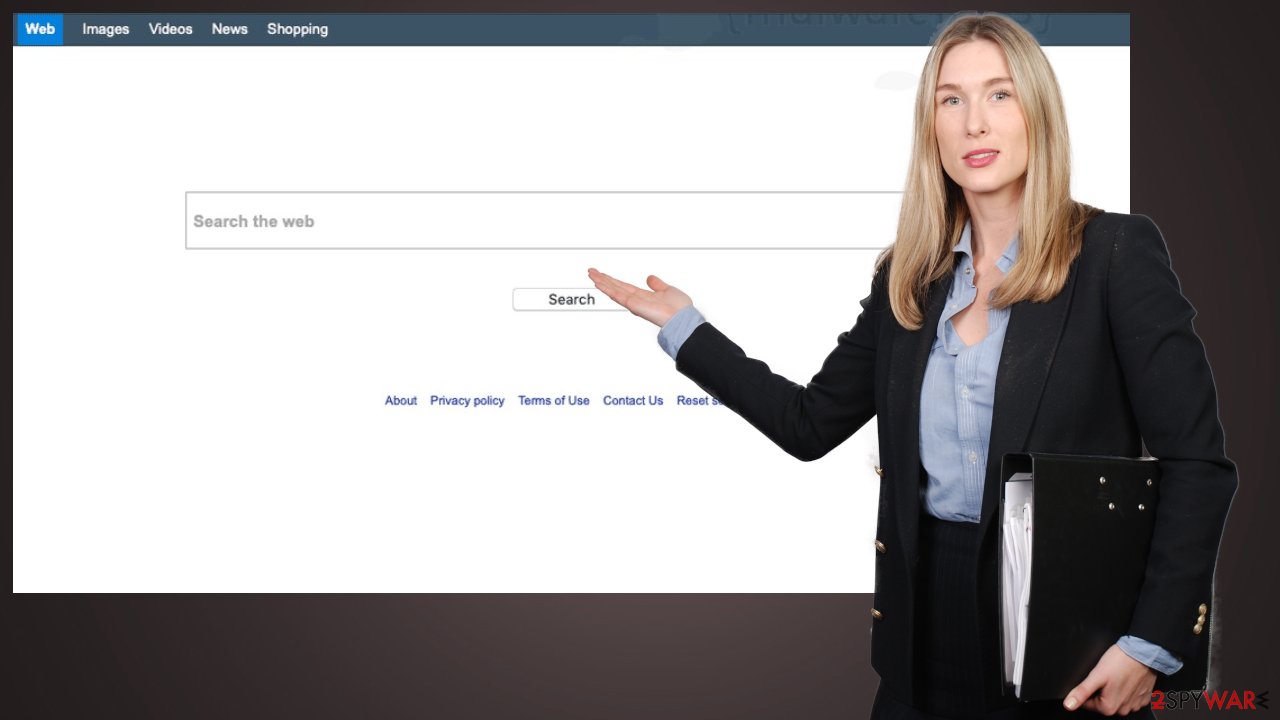Search Symphony Mac Virus (Removal Instructions)
Search Symphony Mac virus Removal Guide
What is Search Symphony Mac Virus?
Search Symphony Mac Virus – a browser hijacker that records browsing activities and causes redirects

Search Symphony is a potentially unwanted program that can be installed on Mac computers. Usually, users do that unknowingly when installing new software from a bundle. Additional apps aren't disclosed, and if you rush through the installation process, all of them are automatically installed on your computer.
When the article's culprit infiltrates the system, whether with your direct approval or without it, it changes certain browser settings, particularly the default search engine, new tab, and homepage preferences. After doing so, the browser hijacker enables data-tracking, redirects, and ad injection.
These are the three main dangers that the Search Symphony Mac virus brings to the table. In this article, we'll elaborate on each of the shady features of the potentially unwanted program, show you how to remove it from your Mac and browsers (if installed as a browser extension), and explain how to fix damages that it might have caused.
| name | Search Symphony |
|---|---|
| Type | Mac virus, browser hijacker, Mac malware |
| Symptoms of infection | Some browser preferences are modified without your direct consent; search inquiries going through a chain of questionable portals; lots of ads in search results; severely diminished browsing speed |
| Altered browser settings | The new tab, default search engine, homepage |
| Risks | Privacy issues, malware infections, additional PUP installation, financial losses |
| Distribution | Software bundles, fake Flash Player updates, deceptive ads, file-sharing platforms |
| Elimination | You can remove any cyber threat from your Mac by performing a full system scan with one of our recommended security tools |
| System health | Optimize your Mac and repair virus damage by using the FortectIntego software |
As we've pointed out earlier, the article's culprit has data-tracking capabilities. It usually collects non-identifiable information, such as geolocations, browsing history, device/browser details, clicked links, search inquiries, etc. These details are used to customize ads specifically for you, making them very alluring.
That takes us to the second and third shady features of the browser hijacker for Mac users. Its ads might seem irresistible as their based on your browsing activities. Usually, browser hijacker ads appear in altered search results. Since Searchsymphony.com is a fake search engine, it redirects to legitimate providers like Google, Yahoo, etc., depending on your geolocation.
But the search results are riddled with ads. They're deemed deceptive as they usually have nothing in common with the web pages you'll land on if such ads are clicked. For example, an ad for a brand new TV might redirect you to a push notification virus domain.
The worst thing is that you may be forced to visit any of the article's culprit's affiliated domains even by trying to close the deceptive ads. Thus, please don't interact with these ads in any way, or you might risk being exposed to websites with tech support scams, gambling, porn, or even severe malware.[1] The next chapter will show you how to eliminate the PUP[2] from your Mac safely.

Remove Search Symphony Mac virus to stop dangerous redirects to shady portals
We're not saying that all websites you'll be redirected to will have bad intentions, but some of them could, so are you willing to risk your privacy and security to find that out? You're better of without the browser hijacker on your Mac. And you have two options to get rid of it.
The first one is automatic removal with the help of the reliable Malwarebytes security tool. Download, install, update, and perform a full threat scan with this trustworthy software, and it will detect and remove Search Symphony from your computer's system along with all its components.
This method is highly recommended because proper security software would also identify any other unwelcomed guests and suggest removing them aswell. If you want to get your hands dirty and try to uninstall the browser hijacker yourself, please be warned that if any essential files or entires are overlooked, the infection could renew itself.
If you still want to do it manually, we'll guide you through the process. These illustrated instructions will help you remove Search Symphony from your Mac:
- From the menu bar, select Go > Applications.
- In the Applications folder, look for all related entries.
- Click on the app and drag it to Trash (or right-click and pick Move to Trash)
![Uninstall from Mac 1 Uninstall from Mac 1]()
To fully remove an unwanted app, you need to access Application Support, LaunchAgents, and LaunchDaemons folders and delete relevant files:
- Select Go > Go to Folder.
- Enter /Library/Application Support and click Go or press Enter.
- In the Application Support folder, look for any dubious entries and then delete them.
- Now enter /Library/LaunchAgents and /Library/LaunchDaemons folders the same way and terminate all the related .plist files.
![Uninstall from Mac 2 Uninstall from Mac 2]()
If you didn't find the browser hijacker in the Applications folder, you would have to look for it with a security tool. In some cases, potentially unwanted programs are purposely installed camouflaged in a different name. If, for some reason, you don't like the aforementioned security tool, you could try using the SpyHunter 5Combo Cleaner.
It's as powerful as the former one, but its GUI (Graphic User Interface) is more suitable for some users. Of course, you could choose another anti-malware tool, but please note that if Search Symphony hijacker slipped by the defenses of the tool you already own – you need an upgrade.
Proper security software is a must for every user that uses the internet regularly. Such software scans all incoming traffic and blocks the latest malware from gaining entry to your device. It will also prevent you from installing PUPs and inform you that you're about to visit a high-risk portal.
Illustrated manuals to delete questionable extensions from Chrome and Safari browsers
Browser hijackers could also be installed as browser plug-ins. Therefore this chapter will help you to look for and remove Search Symphony extension. It could have infected all browsers installed on your Mac, so we're providing instructions for the most popular browser and the default one on all Apple products.
We'll begin with Safari. Follow these instructions to get rid of all suspicious extensions from it:
- Click Safari > Preferences…
- In the new window, pick Extensions.
- Select the unwanted extension and select Uninstall.
![Remove extensions from Safari Remove extensions from Safari]()
When that's done, you have to proceed to the next browser, and since Google Chrome is the most popular browser in the world, it's safe to assume that you have it installed on your Mac. The whole process is fairly simple, but in order to help you, we provide detailed instructions:
- Open Google Chrome, click on the menu (three vertical dots at the top-right corner) and select More tools > Extensions.
- In the newly opened window, you will see all the installed extensions. Uninstall all the suspicious plugins that might be related to the unwanted program by clicking Remove.
![Remove extensions from Chrome Remove extensions from Chrome]()
After accomplishing these steps in continuation, Search Symphony virus, as well as the irritating ads and redirects, will be a thing of the past. Now you can reset your browser settings back to normal. But the whole removal process isn't done yet as you have to repair virus damage.
That includes restoring altered core system settings and deleting tracking cookies that hazardous websites might have stored on your Mac. While you can erase tracking cookies manually, essential system file modifications should be done with compatible system diagnostics software.
IT experts from Japan,[3] strongly recommend entrusting the overall system's health to the time-tested FortectIntego software. It will automatically fix virus damage and optimize your Mac so it could reach peak performance. Furthermore, it can even protect your device from malware. If you have any questions about the removal of the browser hijacker or anything else, please feel free to contact us.
How to prevent from getting browser hijacker
Access your website securely from any location
When you work on the domain, site, blog, or different project that requires constant management, content creation, or coding, you may need to connect to the server and content management service more often. The best solution for creating a tighter network could be a dedicated/fixed IP address.
If you make your IP address static and set to your device, you can connect to the CMS from any location and do not create any additional issues for the server or network manager that needs to monitor connections and activities. VPN software providers like Private Internet Access can help you with such settings and offer the option to control the online reputation and manage projects easily from any part of the world.
Recover files after data-affecting malware attacks
While much of the data can be accidentally deleted due to various reasons, malware is one of the main culprits that can cause loss of pictures, documents, videos, and other important files. More serious malware infections lead to significant data loss when your documents, system files, and images get encrypted. In particular, ransomware is is a type of malware that focuses on such functions, so your files become useless without an ability to access them.
Even though there is little to no possibility to recover after file-locking threats, some applications have features for data recovery in the system. In some cases, Data Recovery Pro can also help to recover at least some portion of your data after data-locking virus infection or general cyber infection.
- ^ Roger A. Grimes. 9 types of malware and how to recognize them. Csoonline. Security news, features and analysis.
- ^ Chris Hoffman. PUPs Explained: What is a “Potentially Unwanted Program”?. Howtogeek. Online technology magazine.
- ^ Uirusu. Uirusu. Spyware news and security.




